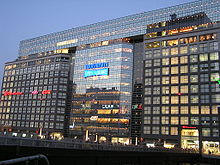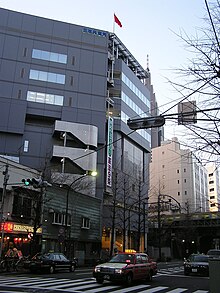Sendagaya
Sendagaya
Thiên đà ヶ cốc | |
|---|---|
Area | |
 Aerial view of Sendagaya | |
| Coordinates:35°40′36″N139°42′29″E/ 35.67659°N 139.70793°E | |
| Country | Japan |
| Region | Tokyo |
| District | Shibuya |
| Time zone | UTC+09:00(JST) |

Sendagaya(Thiên đà ヶ cốc)is an area withinShibuyaward, one of the 23special wards of Tokyo.
Introduction
[edit]
Sendagaya is nestled in an urban green area in Shibuya ward betweenShinjukuward andShinjuku Gyo-en(Shinjuku Imperial Gardens) to the north (an area in Sendagaya, 6-chōme, is actually located within the gardens). The National Stadium, also known asOlympic Stadium, Tokyois located immediately to the east, bordering Sendagaya 2-chome.[1]Meiji ShrineandYoyogi Stationare found to the west. Jingumae andHarajukuare directly south. Many important cultural and sporting venues are located in and around Sendagaya.
Sendagaya is a mix of old, new, and incredibly futuristic designs. FromSendagaya Station,the main station in Sendagaya, bustling Shinjuku is a tranquil 10-minute walk away along the Imperial Gardens' western wall. Sendagaya Entrance to the gardens is 2 minutes away from Sendagaya Station.
Sendagaya, particularly 3-chōme, is home to dozens of clothing and accessory design workshops, studios, offices, and fashion related agencies, including the mega-brandBape.The narrow streets are filled daily with the hustle and bustle of courier companies picking up next season's designs and delivering the finished product.
Theatres
[edit]Sendagaya includes several theaters and organizations related to the arts, such as the NationalNohTheatre, designed by Hiroshi Oe and completed in 1983. Also, the Kinokuniya Southern Theater, the classical music Tsuda Hall ( tân điền ホール), the Japan Federation of Composers, the Japan Theatre Arts Association, the Japan Association of Music Enterprises, the Tokyo Nikikai Opera Foundation, a troupe of opera singers dedicated to promoting and developing the western music movement, and the Japanese Centre of the International Theatre Institute are located in Sendagaya.

Shrines
[edit]A few minutes walk from the station, is the Hato no MoriHachimanShrine(Cưu sâm bát phiên thần xã,Hato no mori hachiman jinja),an oasis of calm with its 300-year-old pine trees. This small shrine is a place of historical importance in Shibuya. Within the shrine, there is a stage for Japanese performing arts and afujizuka,a replica ofMount Fujimade from stones carried from Mt. Fuji. Fujitsuka were common in Japan during theEdo periodand were constructed to allow people to make a symbolic pilgrimage to the sacred Mt. Fuji when travel between domains (han) was not permitted for commoners under most circumstances. This fujitsuka is one of the few that survive in Tokyo.
Sports
[edit]A number of sports' complex are found nearby Sendgaya Station including theOlympic Stadium, Tokyo(which actually sits in Shinjuku-ku) built for the 1958Asian Gamesand subsequently used for the1964 Summer Olympics.Near the stadium, are other important venues, such as Meiji Jingu Skate and Curling Rink and Futsal Courts, theMeiji Jingu Stadiumused by theYakult Swallowsbaseballteam, Jingu Secondary Stadium,Chichibunomiya Rugby Stadium,and theTokyo Metropolitan Gymnasium( đông kinh thể dục quán ).

ModernJapanese architectureis on display directly in front of Sendagaya Station at the metro gymnasium, which houses an Olympic size swimming pool, as well as a shorter 25m pool; an outdoor oval running track; a weight training room; and large indoor arena (photo opposite). The futuristic designed main arena, half built below ground, which seems to hover over the surrounding area, is used for a number of national and international sporting events, including theWTAToray Pan PacificTennis Championships. The Tokyo Metropolitan Gymnasium, built in 1991, was designed by Japanese architect andPritzker PrizewinnerFumihiko Maki.
Embassies
[edit]- Embassy of the Congo, Democratic Republic of (Sendagaya 3-chome)
- Embassy of the Kingdom of Morocco (2-chome)
Education
[edit]Shibuya Board of Educationoperates public elementary and junior high schools.
Sendagaya 2-3chōmeand 1-chōme 1, and 11-12 ban are zoned to Sendagaya Elementary School (Thiên đà cốc tiểu học giáo). Sendagaya 4-6 chōme, and 1-chōme 2-10 and 13-36 ban are zoned to Hatomori Elementary School (Cưu sâm tiểu học giáo).[2]All of Sendagaya is zoned to Harajuku Gaien Junior High School (Nguyên túc ngoại uyển trung học giáo).[3]
-
Sendagaya Elementary School (Thiên đà cốc tiểu học giáo)
-
Hatomori Elementary School (Cưu sâm tiểu học giáo)
Post-secondary schools in Sendagaya:
- Tokyo Design Academy ( đông kinh デザイン chuyên môn học giáo ) (Sendagaya 3-chome)
- Nippon Design College ( nhật bổn デザイン chuyên môn học giáo ) (Sendagaya 5-chome)
- Tsuda School of Business ( tân điền スクールオヴビズネス) (Sendagaya 1-chome)
Business and other ventures
[edit]
- NTT DoCoMo Yoyogi Building(Sendagaya 5-chome)
- Takashimya Times Square,located at the southern exit of Shinjuku Station (Sendagaya 5-chome)
- KinokuniyaBook Store (Sendagaya 5-chome)
- Shinjuku Southern Terrace-OppositeTakashimaya Times Square
- Japanese Communist PartyCentral Committee Headquarters (Sendagaya 4-chome)
- Gap JapanHead Office (Sendagaya 5-chome)
- Japan Shogi Association's headquarters

Transportation
[edit]Rail and Subway Stations
[edit]JRSendagaya Station on theChūō-Sōbu Line( trung ương tổng võ tuyến ) is the neighborhood's main station.Yoyogi Station(JRYamanote Line( sơn thủ tuyến ) and Chūō-Sobu) andShinanomachi Station( tín nùng đinh dịch )are the JR Chūō-Sobu Line stations on either side of Sendagaya.
The southern half ofShinjuku Station,the world's busiest station, is also located in Sendagaya.
Kokuritsu-Kyōgijō Station(E-25), on theToei Ōedo Line( đô 営 đại giang hộ tuyến ), sits in front of Sendagaya Station.
Kitasandō Station( bắc tham đạo dịch ), nearby on Meiji Dōri ( minh trị đạo り), on the newFukutoshin Line( phó đô tâm tuyến ), is run by the Tokyo Metro.
A little further on foot are the stations of Gaienmae ( ngoại uyển tiền ) inMinato-ku( cảng khu ) on theGinza Line( ngân tọa tuyến ),Omotesandōon the Ginza Line,Chiyoda Line( thiên đại điền tuyến ) andHanzōmon Line( bán tàng môn tuyến ) andMeiji Jingu( minh trị thần cung ) on the (Chiyoda Line).
Also, JRHarajukuon the Yamanote Line can be found nearby.
The Royal Platform ( cung đình ホーム), used by theJapanese Imperial Familyduring special occasions, is located along the Yamanote Line in Sendagaya 3-chome.
Roads
[edit]TheShuto Expressway( thủ đô cao tốc đạo lộ Shuto-kōsoku-dōro) passes above Sendagaya running beside the Sobu Line tracks. On/Off ramps for the expressway are in Sendagaya and the neighbouring Shinanomachi area.
Two major urban routes – Meiji Avenue ( minh trị thông り (Rt. 305) and Gaien Nishi Avenue ( ngoại diên tây đạo り) (Rt 418) – run through Sendagaya.
References
[edit]- ^"Yoyogi National Stadium · 2 Chome-1-1 Jinnan, Shibuya City, Tokyo 150-0041, Japan".
- ^"Học giáo biệt thông học khu vực ( tiểu học giáo )".City of Shibuya.Retrieved2022-10-08.- Has elementary zoning
- ^"Học giáo biệt thông học khu vực ( trung học giáo )".City of Shibuya.Retrieved2022-10-08.- Has junior high school zoning




